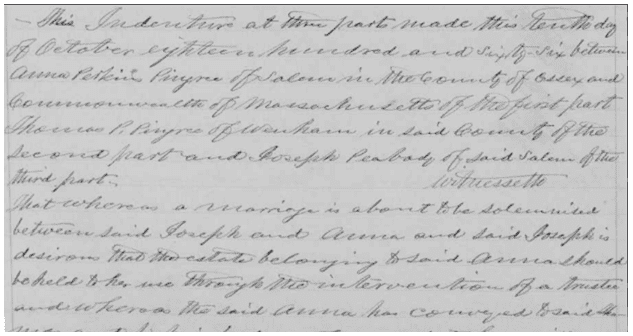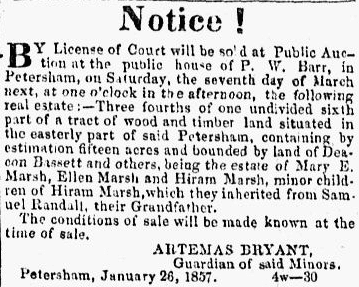Introduction: In this article, Duncan Kuehn discusses a genealogy resource that will help family historians trace their family tree: land records. Duncan is a professional genealogist with over eight years of client experience. She has worked on several well-known projects, such as “Who Do You Think You Are?” and researching President Barack Obama’s ancestry.
Prior to the Civil War, more than 85% of American males owned property! This astonishing statistic shows the importance of using and understanding land records when researching our ancestors. Many genealogists are unaware of the value of these historical documents and the family relationship information that can be gathered from them. Some genealogists are intimidated by these old property records. However, it has been said that land records are the bread and butter of American genealogy research, particularly in the Southern states.
During the Civil War, records were destroyed across many areas in the South—some accidentally by fire, others deliberately by Union troops. Southerners had begun classifying slaves as property similar to land. This was a political move to prevent the North from encroaching on their property rights. When Northern troops attacked Southern towns and cities, they often targeted courthouses to destroy documents recording property—and therefore records of slave ownership.
After the war, Southerners were anxious to protect their property rights and quickly re-filed their land claims. Sometimes these reconstructed land deeds list previous owners and their relationships, providing valuable family history information and clues.
Brief History about Deeds
A deed is a document showing the transfer of land from one private entity (person, company, trust, organization, etc.) to another. These documents record the seller, buyer, and property details. They are usually indexed in two ways: under the name of the grantor (seller), and under the name of the grantee (buyer). The index will list the book and page number to search for the actual recording of the deed.

This deed is between an engaged couple. It goes on to give conditions and qualifications, including a nullification of the deed in the event that the marriage does not take place. Some of the information that we gather from these two paragraphs:
- Anna Perkins Pingree of Salem, MA
- Thomas P. Pingree of Wenham, MA
- Joseph Peabody of Salem, MA
- Joseph and Anna plan to marry
- Anna owns an estate of which Thomas is the trustee
- She received the estate from her father David Pingree, deceased, of Salem, MA
When a married man sold land, his wife was often asked to give a dower release. This meant that after the seller died, his widow could not claim rights to a portion of the land he had previously sold. The dower release will usually list her name.

In this dower release we learn about the following individuals:
- Ferdinand Suydam’s wife, who was named Eliza
- James Boyd Jr’s wife, who was named Maria Ann
Genealogy Clues in Deeds
These land documents can help to distinguish between two individuals with similar names. They can provide the name of the wife. Sometimes they explicitly state other familial relationships such as receiving land from a father, mother, brother, uncle, grandfather, etc. I have even seen deeds which include the last will and testament of an individual. Plotting out the residences of all those with the same last name in an area can help to clarify family groupings. For example if there are two John Smiths in an area, and one owns land near or purchases several plots of land from Robert Smith and the other one is doing the same thing with Simeon Smith, you can build a case for which father belongs to which John Smith.
As you can see, these documents are an important part of a well-researched family history project. Unfortunately, there are some challenges. These documents can be hard to read as the hand writing is not always clear. There is a lot of legal terminology that you will want to become familiar with. Also, not very many of these documents are available online at this point. Fortunately, the sale of land was also recorded in newspapers, which in many cases are available online.
Legal notices in newspapers about land transactions began very early. For example, here is one from 1716, 60 years before the USA became a country.

Genealogy Tip: When reading old newspapers, keep in mind that the letter “s” often appears as an “f.”
This article lists several individuals:
- Doctor Jackson in Marblehead
- Jonathan Springer, deceased, of Glocester (sic)
- John Newman, Esquire, of Glocester (sic)
- John Maule of Salem
All of this information is helpful for the genealogical researcher.
Some land records will list even more information. Here is an example of an 1857 land sale notice that mentions the grandchildren of an individual.

This land sale mentions the following individuals:
- Mary E. Marsh, minor child, daughter of Hiram Marsh, granddaughter of Samuel Randall
- Ellen Marsh, minor child, daughter of Hiram Marsh, granddaughter of Samuel Randall
- Hiram Marsh, minor child, son of Hiram Marsh, grandson of Samuel Randall
- Hiram Marsh, probable son-in-law of Samuel Randall
- Samuel Randall, original land purchaser
- Artemas Bryant, guardian of minor children
- P.W. Barr, owner of auction house in Petersham
- Deacon Bassett, neighbor of Marsh children
Have you used land records in your family history research? What success have you had tracing your family tree with property records?
Related Articles about Property Records for Genealogy:

Have you tried any of the real estate research Web sites?